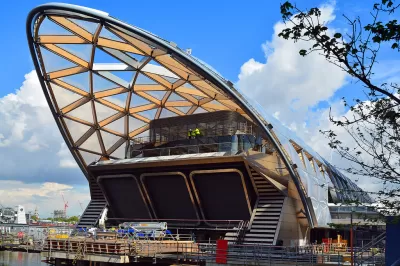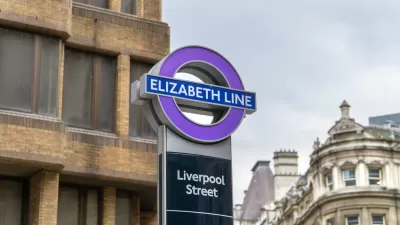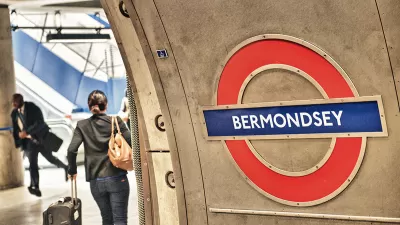London's Crossrail promises faster commutes and neighborhood revitalization in a global economic hub. But what if Brexit puts a damper on that future?

For the New York Times, Michael Kimmelman writes, "Crossrail is not your average subway. London's $20 billion high-capacity, high-frequency train line, which plans to start taking passengers late next year, is billed as Europe’s biggest infrastructure project. It will be so fast that crucial travel times across the city should be cut by more than half."
But the U.K.'s decision to leave the European Union has sown doubts. "Now, with Brexit, the nightmare scenario is that this massive project, to provide more trains moving more people more quickly through a growing city, ends up moving fewer people more quickly through a shrinking city."
In addition to providing for London's elites, Crossrail was conceived with some social good in mind. "While it will whisk bankers at new speeds from their office towers and multimillion-dollar aeries to Heathrow, it will also help millions of now-marginalized, lower-income workers, unable to afford runaway home prices in and around the center of the city, to live in cheaper neighborhoods often far from their jobs."
After Theresa May's campaign threatened to defund a extension to the line, since then "the government's transport secretary has endorsed the project — provided that the city pay half the whopping cost, upfront. The semi-reversal suggested a grudging acknowledgment that, whatever the political fallout or economic prospects, Britain ultimately needs a thriving London all the more after Brexit."
FULL STORY: London’s New Subway Symbolized the Future. Then Came Brexit.

Maui's Vacation Rental Debate Turns Ugly
Verbal attacks, misinformation campaigns and fistfights plague a high-stakes debate to convert thousands of vacation rentals into long-term housing.

Planetizen Federal Action Tracker
A weekly monitor of how Trump’s orders and actions are impacting planners and planning in America.

Chicago’s Ghost Rails
Just beneath the surface of the modern city lie the remnants of its expansive early 20th-century streetcar system.

Bend, Oregon Zoning Reforms Prioritize Small-Scale Housing
The city altered its zoning code to allow multi-family housing and eliminated parking mandates citywide.

Amtrak Cutting Jobs, Funding to High-Speed Rail
The agency plans to cut 10 percent of its workforce and has confirmed it will not fund new high-speed rail projects.

LA Denies Basic Services to Unhoused Residents
The city has repeatedly failed to respond to requests for trash pickup at encampment sites, and eliminated a program that provided mobile showers and toilets.
Urban Design for Planners 1: Software Tools
This six-course series explores essential urban design concepts using open source software and equips planners with the tools they need to participate fully in the urban design process.
Planning for Universal Design
Learn the tools for implementing Universal Design in planning regulations.
planning NEXT
Appalachian Highlands Housing Partners
Mpact (founded as Rail~Volution)
City of Camden Redevelopment Agency
City of Astoria
City of Portland
City of Laramie





























